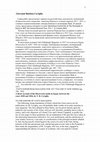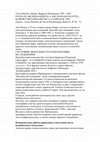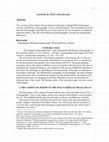Papers by Larisa Urnysheva
Two descriptions of the architectural constructions, the Chamber of Ylion and the Tabernacle of H... more Two descriptions of the architectural constructions, the Chamber of Ylion and the Tabernacle of Hector, have been studied in the present paper. The both were extracted from the medieval Troy History by Guido de Columnis in the Latin and in the illuminated Russian versions. The comparative analysis of the medieval Russian illuminated handwritten History of Troy and of the Latin text of the Historia destructionis Troiae by Guido de Columnis, edited for the Medieval Academy of America by Nathaniel Edward Griffin, is the subject of my present work. In this paper I present the examination of the two fragments from the chapters XXI and XXII of the Troy History, the last passage contains the description of the funeral practice of the Hector body.
Studien zur Altägyptischen Kultur, 2015
The Russian Translation of the Paper: The Bent Pyramid of Snefru at Dahshur has long been the sub... more The Russian Translation of the Paper: The Bent Pyramid of Snefru at Dahshur has long been the subject of investigation in Egyptology. Scholars have
Journal of Historical Archaeology & Anthropological Sciences, 2018
The textual and iconographic analysis of the sepulcher's description and of the burial images in ... more The textual and iconographic analysis of the sepulcher's description and of the burial images in the Medieval Latin and Russian versions of the Story of Troy by Cuido de Columnis is the subject of the present paper. The catalogue of the miniatures with the forms of the sepulchers is composed. Representations of the cadaver two-tier Hector's mausoleum and funerary icon images of Achilles in the sanctuary and Paris in the temple of Juno are fixed.

Серия работ представляет перевод на русский язык документов, публикаций об археологеских открытия... more Серия работ представляет перевод на русский язык документов, публикаций об археологеских открытиях капитана Кавилья в течении периода 1817-1837, о сложных взаимоотношениях синьора Кавилья и полковника Вайс. В данной статье представлен материал из книг Operations Carried On At The Pyramids of Gizeh in 1837. By Colonal Howaed Vyse. Vol. I-II, London 1840. Почему блистательный археолог капитан Кавилья был отстранен от работ в Гизе столь же блистательным исследователем Вайсом в 1837 году, несмотря на то, что Кавилья имел официальный фирман (указ), выданный Мехмед Али Пашой в 1836 году на проведение археологических работ в пирамидах Гизы и окрестностях. В ежегодном издании Tait's Edinburgh Magazine за 1837 год в разделе Egypt, Discoveries in 1820-1836, by Caviglia, опубликован материал, посвященный сложным взаимоотношениям известного археолога с полковником Вайс, который в 1837 году руководил работами в Гизе, и с полковником Кэмпбелл, британским генеральным консулом в Египте. Текст публикация в Tait включает статью анонимного корреспондента из Манчестера, к которому обратился Кавилья с просьбой опубликовать его отчет о его археологических работах в 1820-1836, написанный на итальянском; отчет Кавилья в английском переводе, выполненным, очевидно, анонимным корреспондентом, о работах в 1820-1836; копию писем Кавилья к полковнику Кэмпбелл и его ответ Кавилья. Текст публикации в Tait's Edinburgh Magazine, 1837, полностью воспоизведен во втором томе Вайса, в раделе Appendix (pp. 168-176). Во вступительной статье анонимный корреспондент сообщает о своем знакомстве с Кавилиья и о беседах с ним во время своего пребывания в Египте в 1836-1837, выражает отрицательное отношение к полковнику Вайс и полковнику Кэмпбелл, который не оказал достаточного курирования работам Кавилья, в отличии от своего предшественника Солта, утверждает, что новую камеру над камерой Дэвисона открыл Кавилья, и она должна носить его имя. I. Английский текст и русский перевод статьи в Tait's Edinburgh Magazine за 1837. TAIT'S EDINBURGH MAGAZINE FOR 1837 VOLUME IV NEW SERIES (pp. 704-709) A Brief Account of the Discoveries made in Egypt, between the years 1820 and 1836, hy T. B. Caviglia.
Английский текст и русский перевод I. The Original Text in English Archaeological investigations,... more Английский текст и русский перевод I. The Original Text in English Archaeological investigations, made in the course of the Pyramid studies carried out by the Department of Antiquites, have revealed that two pyramids, one imperfect (bent at the top) and one perfect, were built near the village of Dahshur for Sneferu, first king of the IVth Dynasty, circa 2900 B. C. The skeletal remains to be discussed below were collected from the debris filling one of the chambers inside the second Sneferu pyramid, located to the north of the bent pyramid. The material included some human and some animal remains, which, though very fragmentary, were all in a fairly good state of preservation. Unfortunately no traces of a sarcophagus, canopic jar or any other relevant object have yet been recovered in the same pyramid. The human remains consisted of:

Абу-Раваш, в 25 км к северо-западу Каира, остался в стороне от систематических расследований. Кра... more Абу-Раваш, в 25 км к северо-западу Каира, остался в стороне от систематических расследований. Краткий труд посвящен этому комплексу Э. Чассинат в 1900-1901 гг. Комплекс содержит все компоненты царской гробницы 4-й династии (ок. 2630-2510 гг. до н.э.): погребальный храм, возвышающаяся погребальная дорога и оградка, построенная вокруг монументальных сооружений. Среди них Пирамида Царя, пирамида-спутник, предназначенная для царского поклонения, погребальный храм и полость солнечной ладьи. СОСТОЯНИЕ ДЕЯТЕЛЬНОСТИ И ПЕРСПЕКТИВЫ ИССЛЕДОВАНИЯ Погребальный комплекс был построен фараоном Раджедеф (Джедефра)-le roi Radjedef (старые версии имени фараона: Didoufrî и Djedefrê), чье царствование продлилось примерно с 2580 по 2570 год до н.э. Этот фараон сменил Хеопса и, таким образом, предшествовал царской власти Хефрена и Менкаура. КАМПАНИЯ 1995 г. Благодаря поддержке Швейцарского национального научного фонда "Научные Исследования", была спланирована первая археологическая кампания. Согласно концессии на раскопки, подписанной в начале марта 1995, и оказанного нам доверия нашего коллеги профессора д-ра Абд эль-Халим Нур эд-Дин, Генерального секретаря Высшего совета древностей Египета позволили нам без промедления приступить к работе 8 марта. Они продолжались до тех пор, пока 9 апреля, сотня рабочих размещена под заказ двух «расов» Французского института. Поэтому этот первый сезон был посвящен в первую очередь топографии участка, архитектурных изысканий объектов погребального комплекса и изучению материала, полученного в результате работы в Египте, проведенной в 1994 г. миссией Высшего совета древностей. Проводилась предварительная очистка северной и восточной граней пирамиды, затем инфраструктуры, в поиске камеры царского погребения. Поверхностные работы проведены в восточной части погребального комплекса Архитектурная съемка построек, ранее выставленных на восточная
Mitteilungen des Deutschen Archaologischen Instituts - Abteilung Kairo , 30, 1974
Основная цель состояла в том, чтобы исследовать обе стороны погребальной дороги, ведущей к Тре... more Основная цель состояла в том, чтобы исследовать обе стороны погребальной дороги, ведущей к Третьей пирамиде, в отношении любых погребальных и светских построек, которые могут датироваться Древним Царством. Внимание сосредоточено в первую очередь на южной стороне.
The Ostracon VOLUME 13, NUMBER 1, 2002
Чарльз Ригано
хотя форма изогнутой пирамиды хорошо известна,
его фотографии легко доступны, а сай... more Чарльз Ригано
хотя форма изогнутой пирамиды хорошо известна,
его фотографии легко доступны, а сайт
легко посещаемый, интерьер этой пирамиды все еще является чем-то
тайны. Для такого значительного Старого
Памятник Царства, интерьер получил
только случайное внимание. The Russian Translation of the Paper: New Perspectives on the Interior
of the Bent Pyramid, by Charles Rigano
ANNALES DU SERVICE DES ANTIQUITÉS DE L’ÉGYPTE TOME LII, 1952
The Russian Translation of the Paper: THE SURVEYING OF THE BENT PYRAMID AT DAHSHUR BY HASSAN MUS... more The Russian Translation of the Paper: THE SURVEYING OF THE BENT PYRAMID AT DAHSHUR BY HASSAN MUSTAPHA,
В статье представлены сведения о древнейшей Британии в древнерусских рукописных Хронографах, соде... more В статье представлены сведения о древнейшей Британии в древнерусских рукописных Хронографах, содержащих всемирную историю.

Two versions of the Genesis 48 are analyzed in the paper, English Bible, King James Version, and ... more Two versions of the Genesis 48 are analyzed in the paper, English Bible, King James Version, and Russian chronographic version with illustrations. Three miniatures from the Russian Chronograph, illustrated the text of the Genesis 48, are considered as additional historical sources. The text of the biblical and chronographic versions has insignificant differences. INTRODUCTION The fragment of the handwritten richly illuminated Old Russian Chronograph 1 of the sixteenth century, ff. 142v (below) – 144 (top), corresponding to the chapter 48 of the Genesis 2 , contains three miniatures, ff. 142v, 143, 143v. The text for the first picture is the biblical canonical verses Genesis 48:1-9, the text for the second miniature corresponds to the biblical verses Genesis 48:9-16, and the text for the third picture corresponds to the verses Genesis 48:18-22. The genre-paintings accurately convey the subject of biblical verses, movement in the time and in the space is transmitted by sequential images in one miniature of the persons at different moments of the action. The paintings are multi-figures, the main persons of the topic are depicted in the people's entourage. The Old Russian iconography of the paintings, the main elements of the miniatures such as architectural designs, the bed and the pillow, the clothes of the biblical persons have no analogues in the book illustration, but can not determine the historical time of the events. The Russian reality of the sixteenth century was not a source of the images.
The fragment text of the handwritten illuminated Old Russian Chronograph corresponding to the tex... more The fragment text of the handwritten illuminated Old Russian Chronograph corresponding to the text of Genesis chapter 36 is researched in comparison with the English text of the Old Testament, the Book of Genesis and the Book of Job in the King James Version (KJV). The Russian text of the Genesis 36 contains the chapters of the canonical book of Job with the apocryphal additions. Represented by twenty-five miniatures the illustrated pages comprise several scenes generally arranged in the bands. Some of the Chronograph miniatures are reproduced in the paper.
Two descriptions of the architectural constructions, the Chamber of Ylion and the Tabernacle of H... more Two descriptions of the architectural constructions, the Chamber of Ylion and the Tabernacle of Hector, have been studied in the present paper. The both were extracted from the medieval Troy History by Guido de Columnis in the Latin and in the illuminated Russian versions. The comparative analysis of the medieval Russian illuminated handwritten History of Troy and of the Latin text of the Historia destructionis Troiae by Guido de Columnis, edited for the Medieval Academy of America by Nathaniel Edward Griffin, is the subject of my present work. In this paper I present the examination of the two fragments from the chapters XXI and XXII of the Troy History, the last passage contains the description of the funeral practice of the Hector body.
In current paper the digital reproduction of two imperial diplomatic documents writing in the Ita... more In current paper the digital reproduction of two imperial diplomatic documents writing in the Italien chanceries of Holy Roman Empire are presented: the Charter of the Emperor Guido issued in the year 891 February 2 — Diploma di Guido G6, and the Charter of the Emperor Otto I issued in the year 969 April 18-Privilegium Ottonis I DO 371. The both documents were conserved in episcopal archive of Parma in Italy, the history of their movement from Parmenisse archive is not known, they have been purchased by Russian academician N. P. Lihachev in the end of XIX century or in the beginning of XX century, and the documents are in the funds of Institute of History, Russian Academy of Sciences, now. The digital copies of the charters are received on photocopies of the year 1937 edition by S. A. Anninskii.
The comparative analysis of the medieval Russian illuminated handwritten History of Troy and of t... more The comparative analysis of the medieval Russian illuminated handwritten History of Troy and of the Latin text of the Historia destructionis Troiae by Guido de Columnis, edited for the Medieval Academy of America by Nathaniel Edward Griffin, Medieval Academy Books, No 26 (1936), is the subject of my present work.
Cuido de Columnis Historia Destructionis Troiae consists of prologues, thirty – five books, and t... more Cuido de Columnis Historia Destructionis Troiae consists of prologues, thirty – five books, and the endnote. The History considers the origins and the end of the Trojan War. The first conflict between the Greeks and Laomedon, the Trojan ruler, occurs during Argo expedition, and finishes by the destruction of Laomedonte’s Troy. The first composition of the Guido’s History is Argonautica (books I – III), and the destruction of the Laomedon’s Troy by Jason and Hercules (book IIII).
The history of Priam’s Troy from the foundation of new city to its capture by the Greeks and to the Priam’s death is narrated in the books V – XXX. The capture of Exiona, sister of Priam, daughter of Laomedon, as war gift to Thelamon after ruin of the Laomedon's Troy, was the cause of Priam – the Greeks conflict.
Cuido de Columnis Historia Destructionis Troiae consists of prologues, thirty – five books, and t... more Cuido de Columnis Historia Destructionis Troiae consists of prologues, thirty – five books, and the endnote. The History considers the origins and the end of the Trojan War. The first conflict between the Greeks and Laomedon, the Trojan ruler, occurs during Argo expedition, and finishes by the destruction of Laomedon's Troy. The first composition of the Guido’s History is Argonautica (books I – III), and the destruction of the Laomedonte’ Troy by Jason and Hercules (book IIII).
The history of Priam’s Troy from the foundation of new city to its capture by the Greeks and to the Priam’s death is narrated in the books V – XXX. The capture of Exiona, sister of Priam, daughter of Laomedon, as war gift to Thelamon after ruin of the Laomedon's Troy, was the cause of the Priam – Greeks conflict.
I consider the catalogue of Greek leaders and their ships describing in Liber VIIII.
The Liber XIII of the Guido’ Troy History gives the link between Hercules which was lifeless in t... more The Liber XIII of the Guido’ Troy History gives the link between Hercules which was lifeless in the time of Priam’s Troy, according the world chronicles, and the Agamemnon’ s leadership. The son of Hercules named Thelephus was the warriors of the Greek army.
I research the Achilles’ and Thelephus’ expedition to Messa, and the catalogue of the Trojan allies.
The comparative analysis of the medieval Russian illuminated handwritten History of Troy and of t... more The comparative analysis of the medieval Russian illuminated handwritten History of Troy and of the Latin text of the Historia destructionis Troiae by Guido de Columnis, edited for the Medieval Academy of America by Nathaniel Edward Griffin, Medieval Academy Books, No 26 (1936), is the subject of my present work. An aim of my work is the edition of the parallel Latin – Russian texts of the medieval Troy History as bilingual narratives.
I present marginal notes from the Guido de Columnis Historia Destructionis Troiae, book XVII, the... more I present marginal notes from the Guido de Columnis Historia Destructionis Troiae, book XVII, the fourth battle.
The Greeks questioned the possibility of his victory because of the power and might of Hector, killed many warriors. Killed Patrocl by the sword of Hector, killed Memnon. The night after the third battle Agamemnon shall convene the Council about the fate of Hector, who unanimously decides to destroy the main defender of Troy, the chief and magistrates of the Trojan troops. Mission to destroy Hector lay at Achilles.

Uploads
Papers by Larisa Urnysheva
хотя форма изогнутой пирамиды хорошо известна,
его фотографии легко доступны, а сайт
легко посещаемый, интерьер этой пирамиды все еще является чем-то
тайны. Для такого значительного Старого
Памятник Царства, интерьер получил
только случайное внимание. The Russian Translation of the Paper: New Perspectives on the Interior
of the Bent Pyramid, by Charles Rigano
The history of Priam’s Troy from the foundation of new city to its capture by the Greeks and to the Priam’s death is narrated in the books V – XXX. The capture of Exiona, sister of Priam, daughter of Laomedon, as war gift to Thelamon after ruin of the Laomedon's Troy, was the cause of Priam – the Greeks conflict.
The history of Priam’s Troy from the foundation of new city to its capture by the Greeks and to the Priam’s death is narrated in the books V – XXX. The capture of Exiona, sister of Priam, daughter of Laomedon, as war gift to Thelamon after ruin of the Laomedon's Troy, was the cause of the Priam – Greeks conflict.
I consider the catalogue of Greek leaders and their ships describing in Liber VIIII.
I research the Achilles’ and Thelephus’ expedition to Messa, and the catalogue of the Trojan allies.
The Greeks questioned the possibility of his victory because of the power and might of Hector, killed many warriors. Killed Patrocl by the sword of Hector, killed Memnon. The night after the third battle Agamemnon shall convene the Council about the fate of Hector, who unanimously decides to destroy the main defender of Troy, the chief and magistrates of the Trojan troops. Mission to destroy Hector lay at Achilles.
хотя форма изогнутой пирамиды хорошо известна,
его фотографии легко доступны, а сайт
легко посещаемый, интерьер этой пирамиды все еще является чем-то
тайны. Для такого значительного Старого
Памятник Царства, интерьер получил
только случайное внимание. The Russian Translation of the Paper: New Perspectives on the Interior
of the Bent Pyramid, by Charles Rigano
The history of Priam’s Troy from the foundation of new city to its capture by the Greeks and to the Priam’s death is narrated in the books V – XXX. The capture of Exiona, sister of Priam, daughter of Laomedon, as war gift to Thelamon after ruin of the Laomedon's Troy, was the cause of Priam – the Greeks conflict.
The history of Priam’s Troy from the foundation of new city to its capture by the Greeks and to the Priam’s death is narrated in the books V – XXX. The capture of Exiona, sister of Priam, daughter of Laomedon, as war gift to Thelamon after ruin of the Laomedon's Troy, was the cause of the Priam – Greeks conflict.
I consider the catalogue of Greek leaders and their ships describing in Liber VIIII.
I research the Achilles’ and Thelephus’ expedition to Messa, and the catalogue of the Trojan allies.
The Greeks questioned the possibility of his victory because of the power and might of Hector, killed many warriors. Killed Patrocl by the sword of Hector, killed Memnon. The night after the third battle Agamemnon shall convene the Council about the fate of Hector, who unanimously decides to destroy the main defender of Troy, the chief and magistrates of the Trojan troops. Mission to destroy Hector lay at Achilles.
В работе рассматривается статья "О капище Александрийском"
Following the Flood, God established human life anew on the earth showing His high regard for it. He promised to bless humanity with faithfulness, and He prohibited murder. He also promised with a sign that He would not destroy His creation again with a flood (the Noahic Covenant, Genesis 9:1-17).
The relationship of kinship between Abram and Sarah does not seem entirely clear when comparing the canonical biblical text of the English KJV and the text of the Old Russian Chronograph:
Timeline of Genesis patriarchs: Adam's lineage in Genesis contains two branches: Chapter 4 giving the descendants of for Cain, and Chapter 5 that for Seth that is then continued in later chapters, Noah generation 10.
The first three pages of the fragment (ff. 30, 31, 32) are illustrated by two miniatures each folio.
The text of Chronograph is compared with the English translation of the Old Testament, King James Version (KJV). www.ccel.org
BY AHMED FAKHRY
A small mummy from the pyramid of Dahshur.
centaur, half – man, half -horse, in the Latin and Russian versions of
the Guido de Columna’s Trojan history. The five miniatures from a
Russian illuminated manuscript are presented.The description of the
fantastic creature is contained in the thirteenth chapter of the Trojan
history in the Catalogue of Trojan allies. From the fantastic kingdom
Delissinie, behind the Amazonian land, comes the king Epistropus,
very old, but very wise in the seven sciences. Perhaps the
consequence of his scholarship is the existence of the accompaning
Sagittarius, perfect in the battles with bows and arrows.
photomontages.
The Stones of The Pyramids: Provenance of the Building Stones of the Old Kingdom Pyramids of Egypt / by D. Klemm, R. Klemm. German Archaeological Institute Cairo Department, 2010
Walter de Gruyter, Berlin/New York, pp. 102 – 106.
включает петрографическое определение происхождения строительных камней, сравнительный геохимический анализ блоков пирамид и камней близлежащих карьеров, определение геохимического происхождения материалов ядра и облицовки Незавершённой Пирамиды Сехемхета, Саккара.
at its eastern face. The plan of this city shows that it was designed as a whole. The
straight streets, the regular, intersecting by-ways, the division of the houses into groups, each
having its own granaries and reservoirs, all tend to prove that it was not the haphazard growth
of years. The upper level, to which the stair-way ascends, is occupied by a rock-cut water-tank on the north, and a large granary on the south. The Valley-Temple lies at the south-eastern corner of a vast open area bounded on the north and east by the girdle-wall of the city.
pyramid at Meidum have invoked only occasional comment, which usually only repeats the original
excavation report. Fifty years after its excavation, architects Vito Maragioglio and Celeste Rinaldi
did propose a reconstruction, but since then no one has focused on the monument, which now lies
under the sands once again